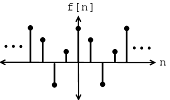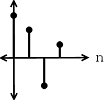| << Chapter < Page | Chapter >> Page > |
In this module, we will derive an expansion for discrete-time, periodic functions, and in doing so, derive the Discrete Time Fourier Series (DTFS), or the Discrete Fourier Transform (DFT).
Since complex exponentials are eigenfunctions of linear time-invariant (LTI) systems , calculating the output of an LTI system given as an input amounts to simple multiplication, where , and where is the eigenvalue corresponding to k. As shown in the figure, a simple exponential input would yield the output

Using this and the fact that is linear, calculating for combinations of complex exponentials is also straightforward.
The action of on an input such as those in the two equations above is easy to explain. independently scales each exponential component by a different complex number . As such, if we can write a function as a combination of complex exponentials it allows us to easily calculate the output of a system.
It can be demonstrated that an arbitrary Discrete Time-periodic function can be written as a linear combination of harmonic complex sinusoids
The - called the Fourier coefficients - tell us "how much" of the sinusoid is in . The formula shows as a sum of complex exponentials, each of which is easily processed by an LTI system (since it is an eigenfunction of every LTI system). Mathematically, it tells us that the set ofcomplex exponentials form a basis for the space of N-periodic discrete time functions.
Say we have the following set of numbers that describe a periodic,discrete-time signal, where : Such a periodic, discrete-time signal (with period ) can be thought of as a finite set of numbers. For example, we can represent this signal as either a periodic signal or asjust a single interval as follows:



Notification Switch
Would you like to follow the 'Signals and systems' conversation and receive update notifications?